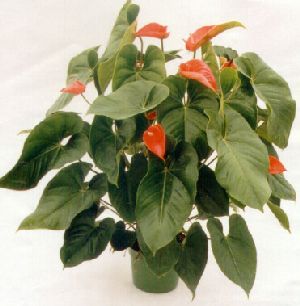
Here is Pinky, our newest addition. She's so pretty! I will add the other plants as I find more info about them.
Anthurium Care
Melody Webster
Anthuriums, also known as Flamingo flowers and pigtail plants, are tropical plants that can be grown as houseplants. They produce very beautiful flowers that last up to eight weeks, and even when not flowering, they work well as foilage plants. To learn how to take care of your anthurium, read on.
Soil
Anthuriums should be potted in a soil that is coarse and well-drained. Use a peat moss base. A 1:1:1 mixture of peat moss, pine bark, and perlite works well. The root system should be allowed to fill the pot before the plant is transplanted.
Light
These plants do well in high light, but not direct sunlight. In order to bloom well, they should not have light levels that are too low. This will halt flower production.
Water
Water your anthurium thoroughly, but allow it to dry slightly between waterings. Over-watering causes root damage and yellowing of the leaves. If the plant becomes too dry it may have tip burn and root damage, but the soil should be dry to the touch before watering again. This procedure will also prevent the appearance of gnats.
Fertilizer
If you want to fertilize your anthurium, use a very light solution with a high phosphorous content. Phosphorous is the middle number in the fertilizer analysis. A high amount of this will promote blooming of the anthurium. Fertilize your plant about every other month.
Problems
Common problems with anthuriums include aphids, scales, mealybugs, thrips, and gnats. To avoid these bugs, do not allow the plant to stay wet, and if they do appear, wiping the foilage often and spraying gently with water is one treatment. If that does not work, pesticides may be used, but always be sure to follow the directions on the label. A disease that sometimes affects anthuriums is RHIZOCTINIA. This is caused by high temperatures and humidity in the presence of poorly drained soil. To prevent this, do not overwater and use well-drained soil. RHIZOCTINIA can be controlled with fungicides.



No comments:
Post a Comment